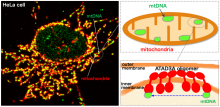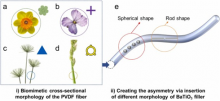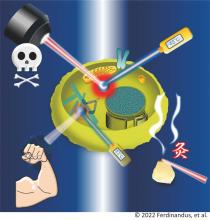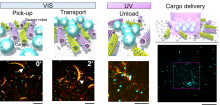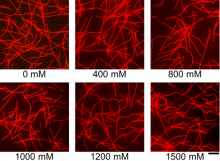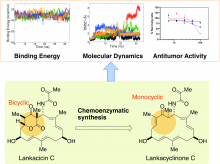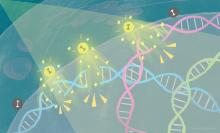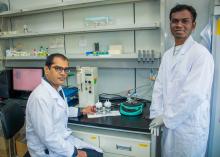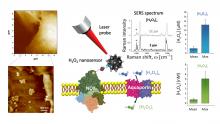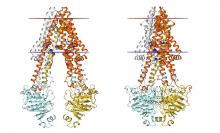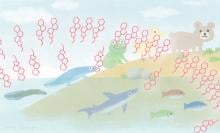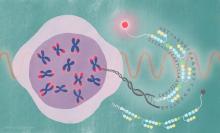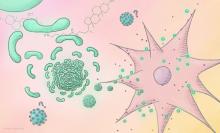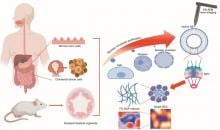Chemistry Chemical biology
News
28 Feb 2024
A new user-friendly tool helps researchers explore how gene activity is influenced by chemical modifications, providing insights into disease and paths to new treatments.
17 Nov 2022
Researchers led by Osaka University have shown that a molecule known as ATAD3A is essential for the movement of genetic material inside cellular substructures called mitochondria. Appropriate distribution of this DNA, organized into “nucleoid” structures, is key for the generation of energy by the “respiratory chain” protein complex. This study opens up opportunities for developing new methods to alter nucleoid movement and affect mitochondrial function, thereby providing potential therapies against mitochondrial diseases.
10 Aug 2022
- Clarified the relationship between the form of piezoelectric fiber components and their piezoelectric performance
- Accelerated commercialization of energy harvesting textile materials that can recycle energy wasted or consumed in everyday life
09 Aug 2022
Researchers at Kanazawa University report in Communications Biology that using common chemicals for fixing living cell samples for microscopy studies causes membrane proteins to aggregate.
08 Aug 2022
Researchers at Kanazawa University report in ACS Nano the development of a nanoparticle that acts as a heater and a thermometer. Inserting the nanoparticle in living cells results in a heat spot that, by switching it on and off, enables the controlled modulation of local cellular activities.
20 Apr 2022
In a global first, scientists have demonstrated that molecular robots are able to accomplish cargo delivery by employing a strategy of swarming, achieving a transport efficiency five times greater than that of single robots.
07 Apr 2022
The molecule trimethylamine N-oxide (TMAO) can be used to reversibly modulate the rigidity of microtubules, a key component of molecular machines and molecular robots.
31 Jan 2022
Garden soil houses a variety of bacteria and their natural byproducts — including one that may help halt tumor growth. Lankacidins are molecules that can be isolated from Strepomyces rochei, a common bacterium in soil. In addition to antimicrobial properties, a type of lankacidins, called lankacidin C, can inhibit tumor activity in various cancer cell lines, including leukemia, melanoma, ovarian and breast cancers. Lankacidin C offers a potential foundation on which to design anticancer drugs, but its structure is complicated and difficult to manipulate, according to an international research group. The same group recently identified where antitumor activity is housed on the molecule and has now used that information to simplify lankacidin as a potential starting point to engineer treatments.
13 Sep 2021
iCeMS scientists and colleagues have designed a molecular code that powers up cancer-fighting immune cells.
26 Aug 2021
A multi-functional, small molecule can tag mutant genetic sequences inside mitochondria for removal.
14 Jul 2021
Researchers have found a way to enhance radiation therapy using novel iodine nanoparticles.
31 May 2021
High-resolution genome structural analyses combined with large-scale simulations show the arrangements of the genome’s spool-like structures affecting gene expression.
13 Apr 2021
Scientists develop high performing electrocatalyst to synthesize ammonia in an effort to replace conventional eco-unfriendly methods
17 Mar 2021
Researchers improve their newly established quantum algorithm, bringing it to one-tenth the computational cost of Quantum Phase Estimation, and use it to directly calculate the vertical ionization energies of light atoms and molecules such as CO, O2, CN, F2, H2O, NH3 within 0.1 electron volts of precision.
08 Mar 2021
Researchers at Kanazawa University report in Biosensors and Bioelectronics a successful test of a sensor for measuring hydrogen peroxide concentrations near cell membranes. The sensor has the potential to become a tool for new cancer therapies.
28 Dec 2020
Investigations of a cellular protein have uncovered a possible link with schizophrenia.
28 Dec 2020
iCeMS scientists have revealed how a transporter protein twists and squeezes compounds out of cells, including chemotherapy drugs from some cancer cells.
23 Dec 2020
A transporter protein that regulates cell membrane cholesterol likely played an important role in vertebrate evolution, according to a review published by iCeMS researchers in the journal FEBS Letters.
10 Dec 2020
A polymer electrode gets an electrical boost for use in E-skin devices.
19 Nov 2020
A repetitive DNA sequence that causes health risks when it malfunctions can now be watched inside living cells using a synthetic tool
01 Oct 2020
Scientists have found an ingredient that makes a vaccine more effective through an approach more often seen in materials science – testing molecules that self-assemble into larger structures.
11 Sep 2020
Measuring the temperature of objects at a nanometer-scale has been a long challenge, especially in living biological samples, because of the lack of precise and reliable nanothermometers. An international team of researchers has realized a quantum technology to probe temperature on a nanometer-scale, and have observed a ‘fever’ in tiny nematode worms under pharmacological treatment. This strengthens the connection between quantum sensing and biology and ushers in novel thermal imaging technologies in biomedical research.
06 Jul 2020
Researchers at Kanazawa University report in Biomaterials a high-speed atomic-force microscopy study of protein filaments in the nuclear pore complex. The visualization in real-time of the filaments’ dynamics is an important step in our understanding of molecular transport mechanisms between a cell nucleus and its surrounding medium.
Events
Sorry, nothing coming up for this discipline
Researchers
Prof. Ganesh Pandian Namasivayam's research goal is to create "Smart Genetic Switches" that precisely ON and OFF the genetic and epigenetic factor(s) of interest.
Tony Z. Jia is a researcher at Japan’s Earth-Life Science Institute (ELSI), based at the Tokyo Institute of Technology. His research focuses on astrobiology, prebiotic chemistry, and origins of life.
Giants in history
Sorry, nothing coming up for this discipline




